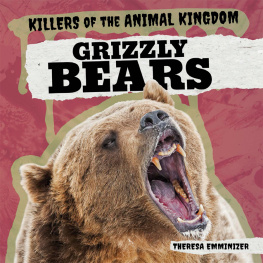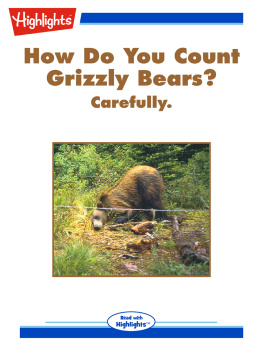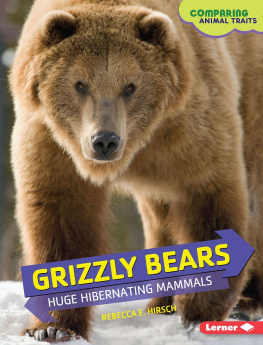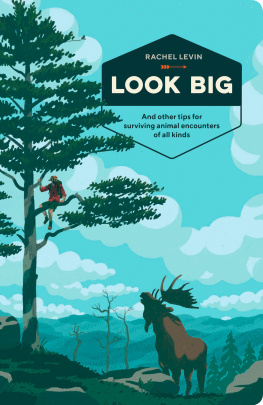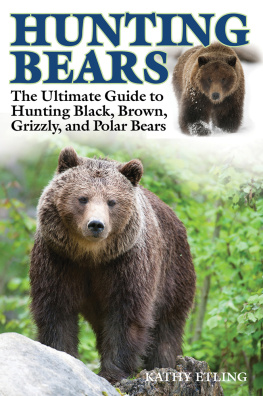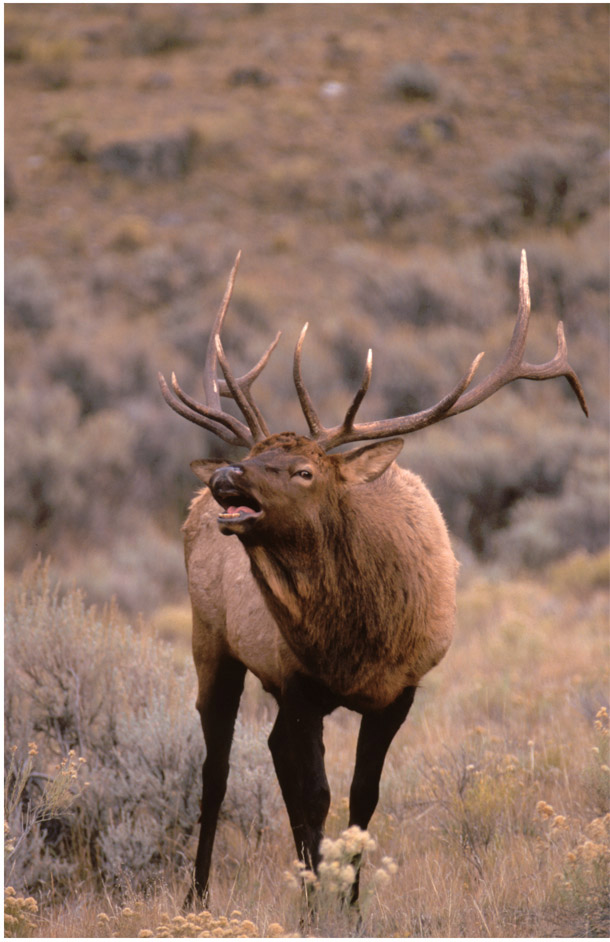ACKNOWLEDGMENTS
Many, many people were instrumental in the writing and production of this book. The work is a culmination of a project that began in 2011 at the request of John Burbidge, acquisitions editor for FalconGuides. He contacted me to request I write a pocket guide on elk. That project grew to include guidebooks for nine of the twelve species covered in this book, much of which is a compilation of those works. Early on in the series, John had the idea of producing an encyclopedic volume of the combined books and is the virtuously patient acquisitions editor responsible for this volume as well, the finishing of which required far more time and effort than I imagined.
Numerous biologists, many of them leading experts in their fields, have generously reviewed and commented upon the portions of the manuscript with which they have acknowledged expertise or have otherwise enlightened my perspective on a particular species. They are: Jamie Jonkel, Shawn Stewart (Montana Dept. of Fish, Wildlife & Parks biologists); Jon Rachael (Idaho Fish & Game Department biologist); Mike Jimenez (former Wolf Management and Science Coordinator, US Fish & Wildlife Service); Dr. Chris Servheen (Professor of Wildlife Biology at the University of Montana and former Grizzly Bear Recovery Coordinator for the US Fish & Wildlife Service); Dr. Bob Garrott (Professor of Ecology at Montana State University); Doug McWhirter (Wyoming Game & Fish Department biologist); Hank Edwards (Wildlife Disease Specialist with the Wyoming Game & Fish Department); Melanie Woolever (National Bighorn Sheep Program Leader, of the US Forest Service); Dr. Brendan Moynahan (former Lead Biologist, National Bison Range); Marilyn Cuthill (formerly of Beringia South, one of the leading mountain lion research centers in the United States); and Sarah Dewey (wildlife biologist at Grand Teton National Park) for reviewing and making helpful comments on the manuscript.
My wife, Lisa, has endured countless hours of hearing the manuscript read aloud and has given many suggestions to give the text clarity. Lisa and my son, Dominic, have generously lent many photos from their files for the book as well.
Swarovski Optics generously provided superb binoculars to aid my field observations of wildlife. Thank you!
CHAPTER 1 ELK
The bugle of a big bull elk is a sound youll never forget.
JACK BALLARD
My earliest memory of a national park involved an elk. On a rare vacation, my family motored to Yellowstone National Park for a long September weekend. As we wound along, frost glittered on flaxen grass in the meadows, and stately, emerald evergreens stood tall and motionless on the hillsides. The sun shone brightly in a cloudless blue sky.
Suddenly, my head nearly banged the front seat when my father slammed on the brakes of our big 1972 Chrysler. With urgency in his voice, he commanded us out of the car. Confused, we bustled out behind him, wondering about the cause of this emergency. Look, he ordered.
Gazing in the direction of his pointed finger, I beheld the first living bull elk Id ever seen. Goring the earth in a tiny meadow with its antlers, the bull lifted its head. Tilting its muzzle, the resplendent animal shattered the mornings tranquility with a resounding bugle. Its breath froze as a great, billowing plume in the frosty air. Even as a second-grader, I knew Id witnessed something spectacular.
Since that first encounter, Ive observed elk for more than four decades. Ive watched herds of wapiti (the American Indian word for elk) grazing alpine pastures in Colorados Rocky Mountain National Park and glimpsed them in the dark timber of Olympic National Park in Washington. Ive spied elk in both of the Dakotasin Theodore Roosevelt National Park in the north, Custer State Park in the southand in countless locations in our national forests.
Im thrilled every time I see them. This chapter is written in hopes it will similarly inspire your own admiration and understanding of these magnificent creatures, no matter where you encounter elk.
NAMES AND FACES
Names and Visual Description
Elk is the name given to a large, hoofed animal of North America. Elk are predominantly brown in color, although their bodies exhibit varying hues. The neck and head of an elk are typically dark brown or chocolate colored. The back and flanks vary from a rich, light brown to tan. Males have antlers and often appear lighter than females on the body, with sides sporting a very pale tan variation or a noticeably yellow coloration. The legs and underbelly of elk are dark, corresponding in color to the hair on the neck and head. Elk rumps appear large and pale in comparison with the rest of their body. Thus, mature elk exhibit a three-toned appearance that lightens when viewed from the front to the rear of the body: dark brown on the head and neck, medium brown to tan on the sides, followed by a lighter, cream-colored or yellowish rump. During the few months of summer when elk are adorned with a shorter hair coat, their overall coloration is more golden or reddish than at other times of the year.
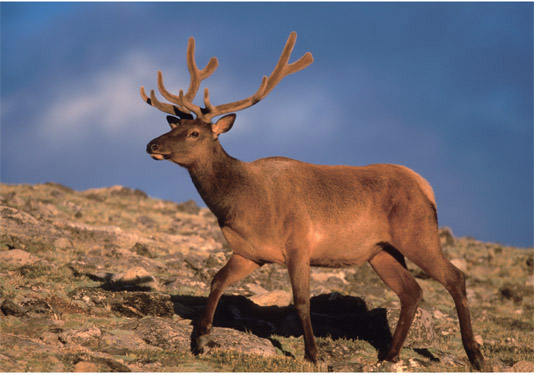
The coat of a fat and sleek bull elk appears reddish brown in summer.
JACK BALLARD
Misapplication of British or European names to North American wildlife was quite common when nonnative peoples began to settle this continent. Such was the case with elk. Elk is actually the word used by British and European people of the colonial era for moose. Incorrectly applied to the more widely distributed elk, the name stuck. Thus, there are currently two species of large, hoofed mammals in the world called elk. Moose, known by the scientific name Alces alces, are called elk in Europe. The elk of North America bear the scientific name Cervus elaphus or Cervus canadensis.
In assigning a scientific name to North American elk, some biologists prefer Cervus elaphus, the same title given to the red deer of Europe, a species that has a noticeably different appearance than North American elk. Proponents of this name note that elk and red deer can interbreed, producing fertile offspring. Scientists championing the Cervus canadensis nomenclature point out the obvious physical differences between red deer and elk that would indicate separate species. They further note that while many species of other animals can interbreed and produce fertile offspring (mallard ducks and pintails, for example), the mere fact that two species can interbreed isnt sufficient reason to classify them as a singular species. So much for the scientists agreeing on everything!
To avoid confusion, many European writers use the name wapiti to refer to North American elk. Wapiti is perhaps the most common secondary name or nickname for elk, and perhaps the most logical moniker when speaking of the species in an international context. Originating from the native tongues of the Shawnee and Cree Indians, wapiti means white rump and refers to this conspicuous portion of an elks anatomy.
Within the species, male elk are known as bulls. Females are called cows, and babies are referred to as calves. Sounds just like domestic cattle, doesnt it? For the first several months of life, calves are easily distinguished from adults not only by their smaller size, but also by their buff, spotted coats.


